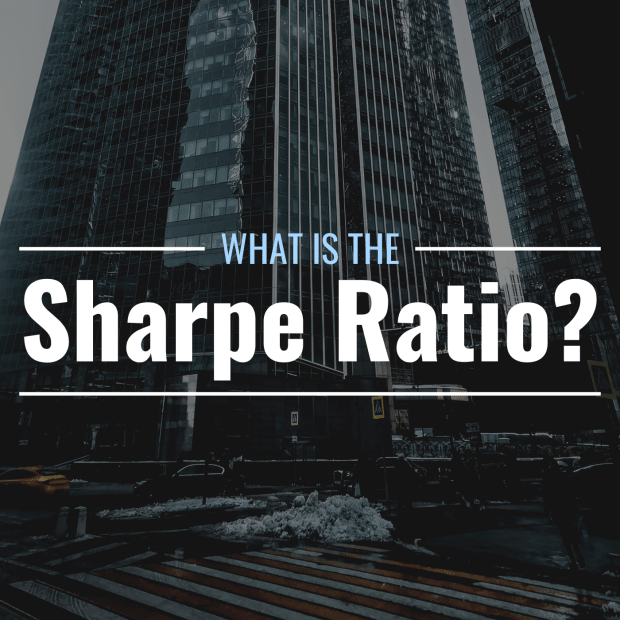
What Is the Sharpe Ratio?
The Sharpe ratio was developed by American economist and Noble laureate William F. Sharpe. This ratio helps investors understand the risk-adjusted returns of their investments (in other words, the return on their investments compared to the risk taken to earn those returns).
The Sharpe ratio is often used to compare the risk-adjusted returns of various investments such as stocks, mutual funds, exchange-traded funds, and investment portfolios.
How Is the Sharpe Ratio Calculated?
The risk-free rate used in the calculation of the Sharpe ratio is generally either the rate for cash or T-Bills. The 90-day T-Bill rate is a common proxy for the risk-free rate.
The Sharpe ratio tells investors how much, if any, excess return they can expect to earn for the investment risk they are taking. Investors should be compensated for taking extra risk beyond holding risk-free assets.
Sharpe Ratio Formula
Sharpe Ratio = (Average Rate of Return on Investment — Risk-Free Rate of Return) / Standard Deviation of Investment.
The average rate of return on the investment would be the average rate for the individual security (stocks, mutual funds, ETFs, etc.) or for the portfolio being measured over the appropriate time period.
If we are calculating the Sharpe ratio of a fund, the process would be to first subtract the return of the risk-free asset from the returns of the fund over the time period being measured. Then divide that number by the investment's standard deviation.
The Sharpe ratio uses the standard deviation of the investment to help measure its risk-adjusted return. Standard deviation is a measurement of the variability of the investment return around the investment's mean return for the time period measured. An investment with a high standard deviation is one whose returns vary widely from its average return.
Why Is the Sharpe Ratio Important?
The Sharpe ratio is often used to judge the performance of investment managers on a risk-adjusted basis. In other words, the manager may have delivered very solid, perhaps even outstanding levels of return over a given time period. The question that the Sharpe ratio attempts to answer is how much risk the manager has assumed to generate those returns. This can be very important in a down-market environment.
What Is Considered a Good Sharpe Ratio?
To calculate the Sharpe ratio on a portfolio or individual investment, you first calculate the expected return for the investment. You then subtract the risk-free rate from the expected return, then divide this sum by the standard deviation of the portfolio or individual investment. This gives you the ratio.
For example, an investment with a return of 6% compared to a risk-free rate of 1.0%, with a standard deviation of +/- 5% would yield a Sharpe ratio of 1.0.
- A Sharpe ratio of 3.0 is considered excellent.
- A Sharpe ratio of 2.0 is considered very good.
- A Sharpe ratio of 1.0 is considered acceptable.
- A Sharpe ratio of less than 1.0 is considered to be poor.
Limitations of the Sharpe Ratio
An investment with a good or bad Sharpe ratio tells only part of the story. The Sharpe ratio needs to be compared to something else to be meaningful. For example, comparing the Sharpe ratios of two or more investment managers is more meaningful. However, it's important to ensure that the comparison is valid. Comparing the Sharpe ratios of a bond manager versus a growth stock manager might tell us that one or the other delivers better risk-adjusted returns, but not much else.
One of the limitations of the Sharpe ratio is that it assumes that the investments measured have a normal distribution of returns. This is not always the case. For example, many types of alternative funds exhibit return patterns that don't fit a normal dispersion.
The Sharpe ratio uses standard deviation as the measurement of risk. Standard deviation measures the variability of an investment's return around its mean (average). Variability includes returns that are both higher and lower than the mean. The reality is that the only type of volatility that investors truly care about is downside volatility or risk.
Example of Using the Sharpe Ratio
Let's look at the Vanguard Growth Index Admiral. It's an index fund that tracks a large growth stock benchmark. Using data via Morningstar as of July 31, 2019:
- Mean return for the trailing 10 years was 15.14%
- The standard deviation for the period was +/- 13.60%
- This means that an investor could expect the return of the fund to have ranged from 28.74% to 1.54% using one standard deviation which covers about 68% of the data sampled.
By comparison, the average fund in Morningstar's large growth category showed the following data for the same trailing 10-year period:
- Mean return for the trailing 10 years was 14.19%
- The standard deviation for the period was +/- 14.06%
Not surprisingly, the Sharpe ratio for Vanguard Growth Index for the period was 1.07, versus 0.97 for the category. The Vanguard fund had both a higher average annual return for the period and a lower standard deviation. As mentioned in the section above, a Sharpe ratio of 1.0 is generally considered acceptable.
What's interesting here is that the Vanguard fund had the same Sharpe ratio as the S&P 500 Index for the period. The S&P's average annual return was 14.03% with a standard deviation of +/- 12.56%
Looking at two Vanguard ETFs in completely different investment categories will show a different result.
Vanguard Dividend Growth is a large-cap stock ETF that invests in companies with a history of increasing their dividends. For the five years ending July 31, 2019:
- Mean return for the trailing 10 years was 11.63%
- The standard deviation for the period was +/- 11.18%
The Vanguard Total International Stock ETF had the following stats for the same period:
- Mean return for the trailing ten years was 2.25%
- The standard deviation for the period was +/- 12.23%
Not surprisingly, the Sharpe ratio for Vanguard Dividend Growth was 0.96 for the period compared to 0.17 for Vanguard Total International Stock ETF.
The question is whether or not comparing an ETF that invests in large-cap, high-quality domestic stocks to one that invests in non-U.S. stocks, including an allocation to emerging market stock is a meaningful one. The Sharpe ratio of VXUS is in line with its benchmark index and its Morningstar category.







